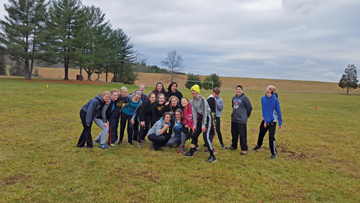You have free articles remaining this month.
Subscribe to the RP Witness for full access to new articles and the complete archives.
R.P.
Like many of you, I am a covenant child, and I grew up with this acronym so frequently around me that it was practically painted on the back of my eyelids. It was the answer to the question, “What church do you go to?” or “Why are you wearing that red shirt with the weird banner on the front?” or “Why does your church have stained glass windows with representations of pulpits in them?”
It has become a definition (RP family, RP girls, RP boys, RP banner, RPIC, etc.) and a distinction (“Oh, you’re the funny people that sing psalms!”). It was used so much that if the letters R and P are next to each other, the rest of the letters—CNA—come out of my mouth like a jack-in-the-box. But I never really thought about what it meant to be part of a denomination that has such an overwhelming influence on so many of us; that is, until one mild night in the sometimes-temperate southern Indiana winter.
That night people from all over the Great Lakes-Gulf region of the U.S. had converged for the 2016-2017 CYPU Winter Conference for the Great Lakes-Gulf Presbytery (an even longer acronym). Pastor David Hanson was giving a series of five lectures on what Christian living means. It means that, as God’s chosen people, we are to do what Christ commands us to do and align ourselves with His example and guidelines. He is our cornerstone. We are His people. And He is fashioning His Church based on His own example. This was the gist of the first talk of the conference, which was about to be driven home to me in a more personal way.
Later that evening I was sitting on a wooden bunk in a particle-board cabin surrounded by seven upperclassmen in high school and a counselor. They came from as close as Lafayette, Ind., and as far as Okinawa, Japan. Most were RPers (another term). All knew of RP churches. At the time, we were introducing ourselves by our full names (middle names and all) and sharing what music we listened to. Some of us listened to bluegrass, others to electronica.
There were a lot of differences in this room, but there was one similarity, namely, that we all knew we were to align ourselves with Christ and we all wanted to do this. This similarity outweighed all the differences. The bluegrass lovers listened with patience to the electronica wafting out of a speaker. The RPers explained TULIP with patience to those less acquainted with RPdom, and a web of friendships was formed that extended across the room. As the conference progressed, God showed me more and more of this web of relationships as it extended across the entire campus. This sort of interconnectedness was something that, as an introspective homeschooler, I had never recognized before.
However, this web had not stretched to its full extent. On the last day, when the conference ended and attendees left to make their way home, this web of people and relationships would extend across 8 states and approximately 990 miles.
Suddenly, that little web that began in a small cabin in a backwoods area of Indiana was now a massive web extending across a significant portion of the RPCNA. This happened because each person who was a part of this network knew we were to align ourselves with Christ and wanted to do so. This Cornerstone that the builders rejected has indeed become the chief Cornerstone of a very large building, of which the RPCNA is a portion. I learned by experience that being part of the RPCNA means being part of a web of people, a brick in the building of Christ’s church in North America and around the globe.
